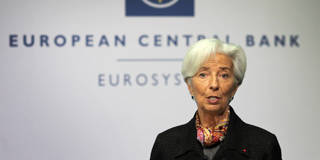Mario Draghi deserves neither hostility nor adulation for his stewardship of the European Central Bank, where he proved adept at working within absurd constraints that forced him to do things that no central banker should ever do. What matters today is that his successor, Christine Lagarde, will have to labor within exactly the same ridiculous constraints.
ATHENS – Shortly after the Eurogroup meeting of Eurozone finance ministers on June 27, 2015, I bumped into a worried-looking Mario Draghi, the president of the European Central Bank. “What on earth is Jeroen doing?” he asked me, referring to Jeroen Dijsselbloem, the Eurogroup’s then-president. “Damaging Europe, Mario. Damaging Europe,” I replied. He nodded, looking concerned. We took the elevator to the ground floor and parted silently.
Journalists find it natural to assume that Draghi and I had a hostile relationship during the 2015 standoff between Greece, which I represented, and the ECB. But the impasse at which we had become stuck was not caused by a clash of characters, and it involved no mutual recrimination. Rather, it reflected an institutional failure for which I never held Draghi personally responsible. Hostility between us, being unnecessary, was absent.
My fleeting exchange with him came to mind as he recently vacated the electric chair amid much speculation about the ECB’s future direction under his successor, Christine Lagarde. It reminded me of the unacknowledged powerlessness of the ECB president, who leads a mighty institution that is far less independent in practice than it is in theory. Lagarde will now have to reckon with that powerlessness as she steers the ECB in a sea of deflationary hazards.

ATHENS – Shortly after the Eurogroup meeting of Eurozone finance ministers on June 27, 2015, I bumped into a worried-looking Mario Draghi, the president of the European Central Bank. “What on earth is Jeroen doing?” he asked me, referring to Jeroen Dijsselbloem, the Eurogroup’s then-president. “Damaging Europe, Mario. Damaging Europe,” I replied. He nodded, looking concerned. We took the elevator to the ground floor and parted silently.
Journalists find it natural to assume that Draghi and I had a hostile relationship during the 2015 standoff between Greece, which I represented, and the ECB. But the impasse at which we had become stuck was not caused by a clash of characters, and it involved no mutual recrimination. Rather, it reflected an institutional failure for which I never held Draghi personally responsible. Hostility between us, being unnecessary, was absent.
My fleeting exchange with him came to mind as he recently vacated the electric chair amid much speculation about the ECB’s future direction under his successor, Christine Lagarde. It reminded me of the unacknowledged powerlessness of the ECB president, who leads a mighty institution that is far less independent in practice than it is in theory. Lagarde will now have to reckon with that powerlessness as she steers the ECB in a sea of deflationary hazards.